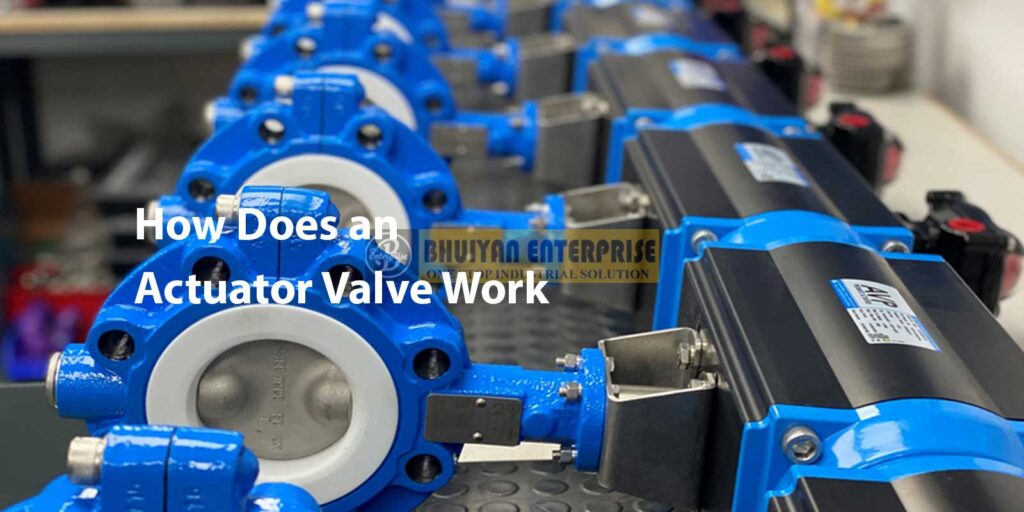
As a content writer and an expert in the field of industrial automation, I’m excited to share with you the inner workings of an essential component – the actuator valve. Actuator valves play a crucial role in controlling the flow and pressure of various fluids and gases, making them indispensable in a wide range of industries, from manufacturing to oil and gas.
In this comprehensive blog post, we’ll dive deep into the mechanics of actuator valves, exploring their different components, types, materials, and how they operate. By the end, you’ll have a thorough understanding of these versatile devices and how they can be leveraged to optimize your industrial processes.
Components of an Actuator Valve
At the heart of an actuator valve lies the valve itself, which is responsible for regulating the flow of the fluid or gas. This valve is typically made of durable materials like stainless steel, brass, or engineered plastics, and its design can vary depending on the specific application.
Surrounding the valve is the actuator, which is the mechanism that provides the force necessary to open, close, or adjust the valve. Actuators can be powered by various sources, including electricity, air pressure (pneumatics), or hydraulic fluid.
The final key component is the control system, which is responsible for directing the actuator to perform the desired actions. This control system can range from simple manual switches to sophisticated digital controllers, depending on the complexity of the application.
Types of Actuator Valves
Actuator valves come in a variety of configurations to suit different needs. Some of the most common types include:
- Globe Valves: These valves feature a circular disc that moves up and down to control the flow of the fluid or gas. They are known for their precise control and are often used in applications requiring accurate flow regulation.
- Ball Valves: These valves use a rotating ball with a hole through the center to open and close the flow path. Ball valves are known for their fast, reliable operation and are commonly used in on/off applications.
- Butterfly Valves: These valves feature a rotary disc that pivots to control the flow. Butterfly valves are known for their compact design and are often used in applications where space is limited.
- Diaphragm Valves: These valves use a flexible diaphragm to open and close the flow path. Diaphragm valves are well-suited for handling corrosive or abrasive fluids and are commonly used in the chemical and pharmaceutical industries.
Key Materials Used in Actuator Valves
The materials used in the construction of actuator valves are critical to their performance and longevity. Some of the most common materials include:
- Stainless Steel: Stainless steel is a popular choice for actuator valves due to its corrosion resistance, strength, and durability. It is often used in applications involving harsh environments or corrosive fluids.
- Brass: Brass is a versatile alloy of copper and zinc that is commonly used in actuator valves. It offers good corrosion resistance and is often more cost-effective than stainless steel.
- Engineered Plastics: Specialty plastics, such as PTFE (Teflon) or PEEK, are increasingly being used in actuator valves due to their chemical resistance, low maintenance requirements, and lightweight properties.
- Elastomers: Flexible materials like rubber or various polymers are used to create the seals and gaskets that ensure a tight, leak-proof seal in the actuator valve.
The choice of materials will depend on the specific application, operating conditions, and the nature of the fluid or gas being controlled.
How Actuator Valves Operate
Actuator valves work by converting various forms of energy into mechanical force to open, close, or adjust the valve. Let’s explore the different types of actuators and how they function:
Electric Actuators
Electric actuators use an electric motor to provide the necessary force to operate the valve. When the control system sends an electrical signal, the motor turns, which in turn moves the valve to the desired position. Electric actuators are known for their precision, speed, and ease of integration with digital control systems.
Pneumatic Actuators
Pneumatic actuators use compressed air to generate the force required to operate the valve. When the control system sends a signal, the actuator uses the air pressure to push or pull the valve open or closed. Pneumatic actuators are known for their reliability, simplicity, and suitability for use in hazardous environments.
Hydraulic Actuators
Hydraulic actuators use pressurized fluid, such as oil, to provide the force needed to move the valve. The control system directs the flow of the hydraulic fluid, which in turn moves the valve. Hydraulic actuators are known for their high power output and ability to handle heavy-duty applications.
Manual Actuators
In some cases, actuator valves can be operated manually, without the use of any external power source. These manual actuators, such as handwheels or levers, allow the operator to physically turn the valve to the desired position. Manual actuators are often used as a backup or in applications where automated control is not required.
Regardless of the type of actuator, the control system plays a crucial role in dictating the valve’s behavior. This control system can range from simple on/off switches to complex programmable logic controllers (PLCs) that allow for precise, automated control of the valve’s position and responsiveness.
Conclusion
Actuator valves are essential components in a wide range of industrial applications, from process control to environmental management. By understanding the various types of actuators, the materials used in their construction, and how they operate, you can make informed decisions about which actuator valve best suits your needs.
Whether you’re working in manufacturing, oil and gas, water treatment, or any other industry that requires precise control of fluids and gases, mastering the intricacies of actuator valves can help you optimize your processes, improve efficiency, and ensure the safety and reliability of your operations.
FAQ
- How do actuator valves differ from manual valves? Actuator valves are designed to be automatically operated by a power source, such as electricity, air pressure, or hydraulic fluid, while manual valves require a human operator to physically turn the valve to the desired position. Actuator valves offer greater precision, speed, and ease of integration with control systems compared to manual valves.
- What are the advantages of using an actuator valve over a manual valve? Actuator valves offer several key advantages:
- Improved precision and control over the valve’s position
- Faster response times and the ability to automate processes
- Reduced risk of human error or inconsistency in valve operation
- Suitability for use in remote or hazardous environments where manual operation may be impractical or unsafe
- Easier integration with digital control systems and process automation
3. How do I choose the right type of actuator valve for my application? The type of actuator valve you should choose will depend on factors such as the fluid or gas being controlled, the operating environment, the required speed and precision of the valve, and the availability of power sources. It’s important to carefully evaluate your specific needs and consult with experts to determine the most suitable actuator valve for your application.

